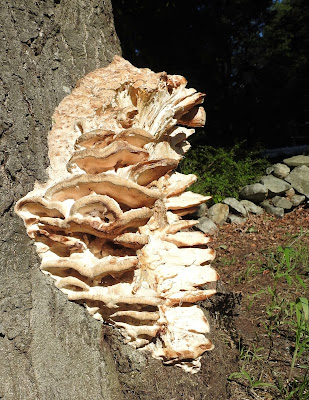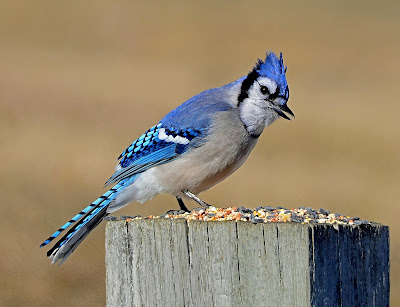Chicken of the Woods, a fungi unlike any other
by Sue Pike
appeared week of August 28 2017 in the York Weekly, Portsmouth Herald, Foster's Daily and more
I was hiking up Mt Moosilauke last weekend. Toward the start, about 20 feet back from the trail, a Chicken of the Woods mushroom beckoned to us. The size of a stop sign, at least a couple pounds in weight, its bright yellow color glowing, it seemed to be asking us to come collect and eat it. We still had many miles to go so we decided to pick it up on the return. Coming back down we looked and looked but couldn’t find it, I think this loss is probably going to haunt me forever. It looked like the most perfect Chicken of the Woods fungi I have ever seen.
 |
| Chicken of the Woods on an old oak Sue Pike photo |
While I love the subtlety of nature, I also like things that are easy to identify - blue jays and cardinals, oak and maple trees, and edible mushrooms that cannot be mistaken for anything else. Chicken of the Woods fungi are one such mushroom. If you know a little bit about mushroom anatomy they really are unmistakable.
Chicken of the Woods mushrooms are a large, choice edible mushroom, easily recognized by their bulky overlapping, fan-shaped shelves. The true Chicken of the Woods, Laetiporus sulphureus, is bright yellow, but there are a number of different species in this group (Laetiporus is the genus, sulphureus is the species). Another clue that you’ve found an actual Chicken of the Woods is found on the underside of the cap. These are polypore mushrooms. This means that instead of gills under the cap they have small pores, the underside of the cap almost looks like a solid surface.
Chicken of the Woods mushrooms are saprotrophic (meaning they feed on dead trees) and parasitic (they also kill living host trees by causing the wood to rot). This is an important fact to be aware of. According to Tom Volk (University of Wisconsin-La Crosse) both species “cause a brown rot, and both are common reasons that trees fall over or break in the wind.” So, it really isn’t awesome to have these growing on those stately old oaks that line your drive.
 |
| The undersides have pores not gills Sue Pike photo |
Until I was researching this column I thought that the name, Chicken of the Woods, was referring to the growth form of these fungi - the overlapping shelves look like a turkey or chicken tail - but most accounts reference their taste and texture, prepared correctly they can have the same taste and texture as chicken.
Chicken of the Woods are highly variable when it comes to taste -- some taste great, some don’t. They’re best when young and fresh. In his book “Edible and Medicinal Mushrooms of New England and Eastern Canada,” David Spahr describes how to decide whether your specimen is a choice edible. “Chicken of the Woods grow very fast. Usually when you find one specimen, there will be many more. Immediately after you remove a younger specimen, it may have a large amount of clear, watery juice that pours -- almost like a faucet -- out of the specimen and its host. This is a sign that the specimen will be a choice edible.” Sadly, I seem to find them when they are old and not very good.
Even though this is one of those fungi that is hard to mistake for anything else, always be careful when collecting - check and check again. Spahr cautions that “a few people may have sensitivity to Chicken of the Woods so if it is your first time, taste only a small amount.” He also cautions that you should only harvest ones growing on hardwood trees, specimens growing on conifers are probably a different species need to be treated with caution. As with all fungi, it is never a good idea to go foraging unless you have trained with an expert.



Comments
Post a Comment